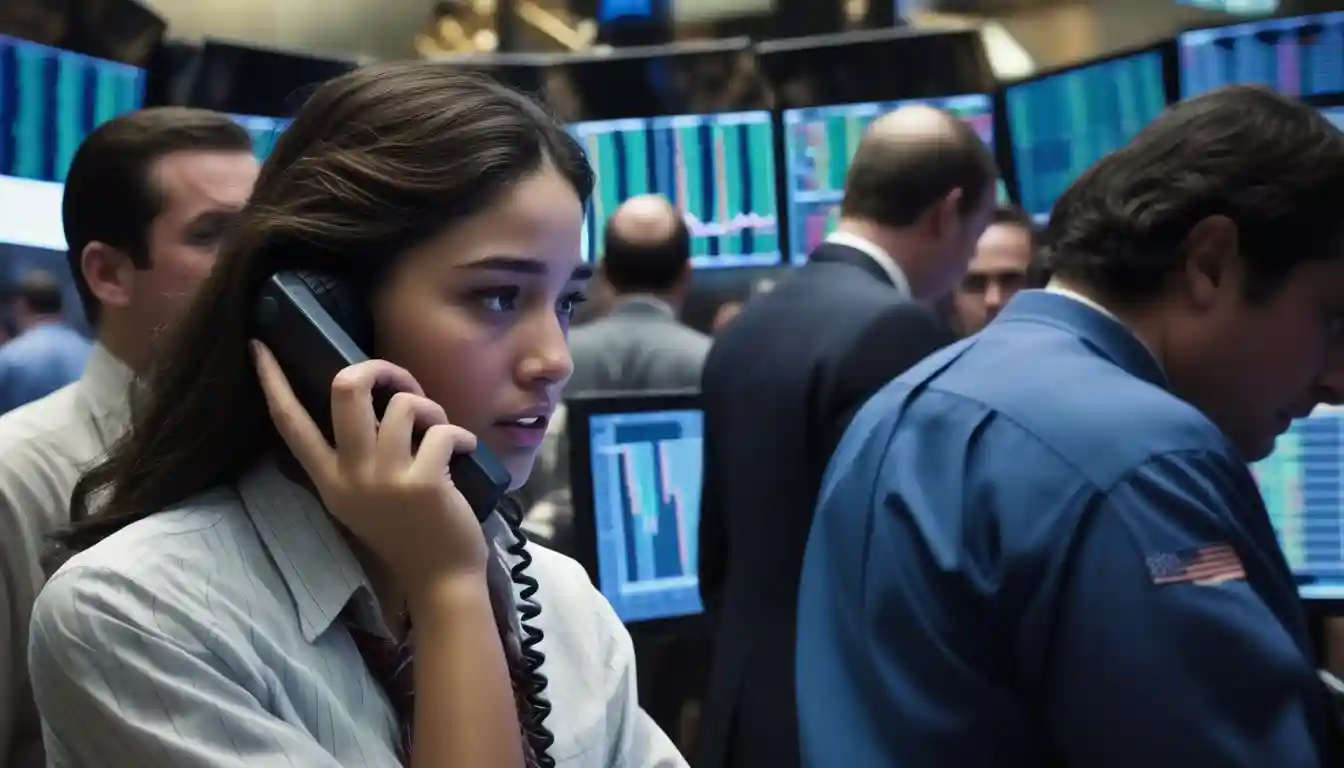
eToro Beats Profit Forecasts But Stock Falls as Trading Activity Cools From Spring Highs
eToro's Public Market Debut: When Retail Revolution Meets Wall Street Reality

The Paradox of Success in a Normalizing Market
Today, eToro Group Ltd. delivered what should have been a celebration-worthy earnings report. The social trading platform's first quarterly results as a public company exceeded every Wall Street metric that matters: adjusted earnings per share of $0.56 crushing the $0.50 consensus, net contribution surging 26% year-over-year to $210 million, and assets under administration exploding 54% to $17.5 billion.
Yet by market close, eToro's shares had tumbled 8%, illustrating the brutal arithmetic of public markets where beating expectations often isn't enough—especially when the underlying engine showing signs of cooling.
eToro's stock performance following its Q2 earnings report, showing an initial dip despite positive results.
| Date | Closing Price | Daily Change (%) | Notes |
|---|---|---|---|
| August 11, 2025 | $57.93 | Pre-earnings announcement. | |
| August 12, 2025 | $55.30 | -4.54% | eToro reported strong Q2 2025 results, beating analyst expectations. Despite this, the stock dipped in early trading. |
| August 13, 2025 | $56.20 | +1.63% | Stock showed a slight recovery following the previous day's dip. |
The disconnect reveals something profound about the current moment in financial markets: the retail trading revolution that has powered fintech platforms like eToro to unprecedented heights may be entering a more mature, and potentially more volatile, phase.
When David Disrupts Goliath: The Retail Trading Renaissance
The numbers behind eToro's performance tell the story of a fundamental shift in how investing happens. The platform's 3.63 million funded accounts represent a 14% year-over-year increase, but more telling is the $17.5 billion in assets under administration—money that five years ago would have sat in traditional brokerage accounts charging substantially higher fees.
This isn't merely about lower costs. eToro's success reflects a generational change in investment behavior, where younger, tech-savvy investors have embraced platforms offering 24/5 trading capabilities, access to over 100 cryptocurrency assets, and AI-powered investment strategies called Alpha Portfolios. The company's recent launch of after-hours trading for U.S. equities represents a direct challenge to the traditional market structure that has governed Wall Street for decades.
Financial industry veterans note the significance of this disruption. "We're witnessing the democratization of sophisticated trading tools that were once exclusive to institutional players," explains one senior analyst at a major investment bank who requested anonymity. "The question isn't whether this trend will continue—it's whether platforms like eToro can maintain their edge as competition intensifies."
AI-powered investment portfolios, often known as robo-advisors, use artificial intelligence to automate asset management. These platforms analyze vast amounts of market data to build, monitor, and automatically rebalance a portfolio based on your financial goals and risk tolerance.
The Crypto Concentration Conundrum
Beneath eToro's impressive headline numbers lies a more complex reality that sophisticated investors cannot ignore. Under IFRS presentation standards, an staggering $1.915 billion of the company's $2.094 billion in revenue derived from cryptoassets—representing over 90% concentration in what remains one of the most volatile asset classes in modern finance.
A pie chart illustrating eToro's heavy reliance on cryptocurrency, which accounts for over 90% of its revenue.
| Period | Total Commission Income | Crypto Revenue Share | Equities Revenue Share | Commodities Revenue Share | Currencies Revenue Share |
|---|---|---|---|---|---|
| 2024 | $931 million | 38% | 38% | 20% | 4% |
| 2023 | $639 million | N/A | N/A | N/A | N/A |
| Q2 2025 | $210 million | N/A | N/A | N/A | N/A |
This concentration creates both tremendous opportunity and existential risk. When cryptocurrency markets surge, as they have periodically throughout 2025, eToro's revenue engine operates at maximum efficiency. When crypto volatility subsides or prices decline, the platform faces immediate pressure on both trading volumes and revenue per user.
The company's management team, led by CEO Yoni Assia, appears acutely aware of this vulnerability. eToro's recent partnership with Franklin Templeton for long-term investment portfolios and expansion into traditional savings products in France represent deliberate efforts to diversify revenue streams beyond the crypto-dependent model that has driven growth to date.
Geographic Chess Moves in a Regulatory Landscape
While much attention has focused on eToro's financial metrics, the company's strategic positioning reveals sophisticated thinking about long-term sustainability. The activation of its Monetary Authority of Singapore license and establishment of Singapore as its Asian hub represents more than simple geographic expansion—it's a hedge against regulatory uncertainty in Western markets.

This move gains particular significance as European Union markets adapt to the Markets in Crypto-Assets (MiCA) regulation, which could standardize cryptocurrency trading across member states. Early positioning in Asia provides eToro with diversified regulatory exposure and access to markets where retail investment culture continues expanding rapidly.
Did you know that the EU's Markets in Crypto-Assets Regulation (MiCA), fully effective since late 2024, is the first comprehensive legal framework harmonizing crypto-asset rules across all EU countries? It creates a uniform licensing system for crypto businesses, enhances investor protection, and addresses risks from various crypto-assets like e-money tokens and asset-referenced tokens. MiCA ensures transparency, governance, and market integrity while fostering innovation in digital finance by enabling crypto companies to operate seamlessly across the entire European Union with a single regulatory regime. This landmark regulation is overseen by EU authorities such as ESMA and national regulators, marking a major step toward safer and more transparent crypto markets in Europe
The company's $1.2 billion cash position—accumulated through its May 2025 initial public offering—provides substantial ammunition for potential acquisitions, particularly in the U.S. market where competition with established players like Robinhood and newer entrants remains intense.
The Normalization Reality Check
CFO Meron Shani's commentary during the earnings call revealed the challenge facing all retail-focused trading platforms: sustainability of elevated activity levels. The "normalization" of trading activity from April's post-tariff surge represents a return to baseline levels that, while still healthy, cannot match the extraordinary volumes that drove exceptional first-quarter performance.
The trend of retail trading volumes across major platforms, indicating a 'normalization' from the peak activity of previous quarters.
| Quarter | Platform | Equities Trading Volume (USD Billion) | Options Trading Volume (Contracts in Millions) | Cryptocurrency Trading Volume (USD Billion) | Total Retail Trading Volume (USD Billion) |
|---|---|---|---|---|---|
| Q1 2024 | Coinbase | - | - | 56 | 56 |
| Q1 2024 | Robinhood | 413 | - | 46 | 459 |
| Q4 2023 | Coinbase | - | - | 29 | 29 |
| Q4 2023 | Robinhood | 423 | 477 | 71 | 971 |
| Q3 2023 | Coinbase | - | - | 11 | 11 |
| Q3 2023 | Robinhood | - | - | 14.4 | 14.4 |
| Q2 2023 | Coinbase | - | - | 14 | 14 |
| Q2 2023 | Robinhood | - | - | 21.5 | 21.5 |
This normalization pattern has affected the broader fintech trading sector. Coinbase executives recently flagged subdued July transaction volumes, while Robinhood has increasingly emphasized its options trading and interest-bearing account features to reduce dependence on pure equity trading volumes.
For eToro, sequential deceleration from Q1's $217 million net contribution to Q2's $210 million, despite the year-over-year beat, signals that even successful execution cannot fully offset broader market dynamics.
Valuation Mathematics in an Uncertain Environment
At approximately $51 per share and 83.7 million shares outstanding, eToro commands a market capitalization near $4.26 billion. Adjusting for its substantial cash position yields an enterprise value of roughly $3.06 billion—representing approximately 10.6 times run-rate adjusted EBITDA based on Q2 performance.
Did you know that while Market Capitalization measures a company's equity value by multiplying its share price by outstanding shares, Enterprise Value provides a more complete picture of a company’s worth by including its debt and subtracting cash? This makes Enterprise Value a better gauge of the true cost to acquire a company, reflecting its entire capital structure, whereas Market Cap only shows what the market values the company’s equity at a glance. Consequently, Enterprise Value is often preferred in mergers, acquisitions, and fundamental analysis for a fuller understanding of a company's financial health and real economic value.
This valuation appears reasonable for a platform demonstrating execution capability and growth optionality, but scenario analysis reveals the importance of continued diversification. Conservative projections suggesting EBITDA in the $200 million range could support equity values around $38 per share, while more optimistic scenarios assuming successful platform expansion and sustained engagement could justify valuations approaching $68 per share.
The wide range reflects the inherent uncertainty in a business model still heavily dependent on cryptocurrency market dynamics and retail investor sentiment.
Investment Implications for Professional Traders
For institutional investors and professional traders, eToro represents both a compelling secular trend and a tactical timing challenge. The company's strong execution on product development, geographic expansion, and user engagement suggests management capability to navigate competitive pressures.
However, the extreme cryptocurrency concentration creates volatility that professional portfolios must carefully consider. The reflexive nature of retail trading—where success breeds more activity while downturns can rapidly compound—means eToro's business model will likely experience amplified cycles relative to broader market movements.
Market participants should monitor several key indicators: the breakdown of net contribution between cryptocurrency and traditional assets, organic deposit flows versus market appreciation in AUA calculations, and adoption rates for new products like 24/5 equity trading and AI-driven portfolios.
Additionally, eToro's substantial cash position and acquisition intentions warrant attention, as successful acquisitions could accelerate diversification while unsuccessful ones could destroy capital in a rapidly evolving competitive landscape.
The Road Ahead: Evolution or Revolution
eToro's first public earnings report illuminates the complex dynamics facing fintech platforms attempting to institutionalize retail trading innovation. The company has demonstrated the ability to attract and retain users, expand product offerings, and execute operationally during the challenging transition to public company status.
Yet the fundamental question remains whether eToro can successfully evolve from a cryptocurrency-dependent platform to a diversified financial services provider while maintaining the growth rates that have attracted investor interest. The company's success will likely determine not just its own trajectory, but serve as a crucial test case for the broader fintech revolution in financial services.
For now, eToro has proven it can beat expectations and execute strategy even as market conditions normalize. Whether that proves sufficient for long-term value creation will depend on management's ability to diversify revenue streams while preserving the innovative edge that originally disrupted traditional finance.
NOT INVESTMENT ADVICE